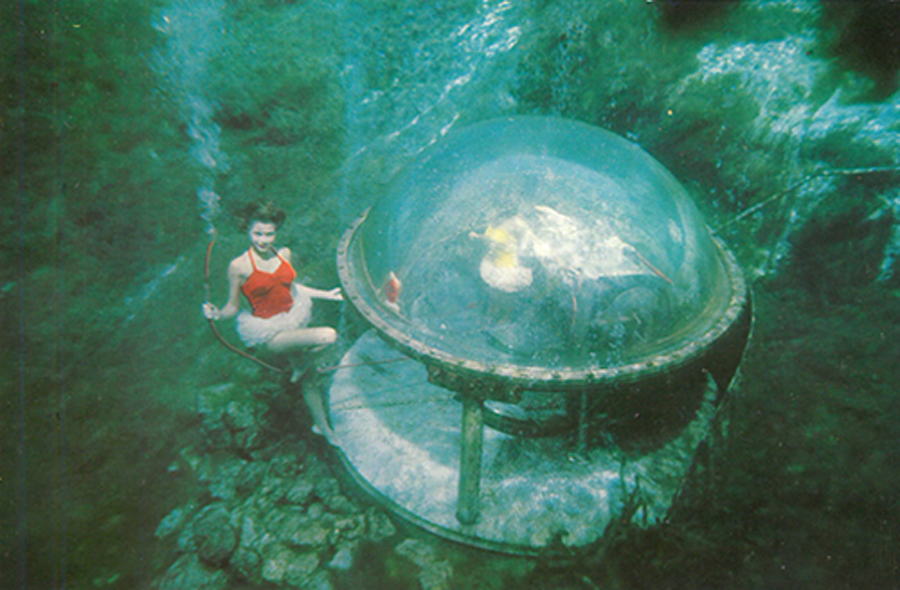Weeki Wachee Springs Added to National Register of Historic Places

TALLAHASSEE, FL – Secretary of State Laurel M. Lee announced today that Weeki Wachee Springs in Weeki Wachee, Florida has been listed on the National Park Service’s National Register of Historic Places.
“Weeki Wachee Springs is one of Florida’s most unique and beloved tourist attractions,” said Secretary of State Laurel M. Lee. “I am pleased to see the park’s history honored through listing on the National Register.”
Weeki Wachee Springs is a historic roadside attraction that is located in Hernando County, Florida. Best known for its underwater theater and live mermaid performances, Weeki Wachee first opened to tourists in 1947. The attraction reached great popularity in the 1960s and 1970s under the ownership of the American Broadcasting Company (ABC). Today, Weeki Wachee is a Florida State Park that continues to feature underwater mermaid performances 365 days a year.
Weeki Wachee’s underwater theater and performing mermaids were the brainchild of Newton Perry, an accomplished swimmer and underwater performer who had previously worked at two other Florida attractions: Silver Springs and Wakulla Springs. Perry installed a series of air hoses and airlocks at the bottom of the spring, allowing mermaids to stay underwater for long periods of time during performances.
Perry’s vast experience working with Hollywood directors on underwater film sequences at Silver Springs and Wakulla Springs, including the Tarzan franchise, drew future TV and film projects to Weeki Wachee. The 1948 film Mr. Peabody and the Mermaid, and a host of TV shows and film shorts were filmed beneath the surface of the spring in the following decades.

Weeki Wachee Springs is also significant for the architecture of its underwater theater, constructed in 1960. Submerged beneath the surface of the spring and topped with a distinctive clamshell roof, the theater was designed by Robert E. Collins, a prolific Florida architect who designed at least fifteen other theaters, including three National Register-listed theaters in the Miami Beach Architectural District.
The park also contains a significant archaeological site: the Weeki Wachee mound. Discovered in 1969 while a worker was clearing land with a tractor, the Native American burial mound dates to the Safety Harbor period (A.D. 1300-1725), referring to indigenous people who lived in west Florida at the time of European contact in the early sixteenth century.
Weeki Wachee Springs became a Florida State Park in 2008 and now welcomes visitors 365 days a year. A new generation of mermaids perform shows daily in the underwater theater. For more information on the history of Weeki Wachee Springs and how to plan your visit, go to weekiwachee.com.
About The National Register of Historic Places
The National Register of Historic Places is a list maintained by the National Park Service which includes historical or archaeological properties including buildings, structures, sites, objects, and districts, that are considered worthy of preservation because of their local, statewide and/or national significance. Nominations for properties in Florida are submitted to the National Park Service through the Florida Department of State’s Division of Historical Resources. Florida has over 1,700 listings on the National Register, including 295 historic districts and 175 archaeological sites. There are more than 50,000 sites contributing to the National Register in Florida. For more information, visit here. For more information about the National Register of Historic Places program administered by the National Park Service, visit nps.gov/nr.
The Florida Department of State’s Bureau of Historic Preservation
The Bureau of Historic Preservation (BHP) conducts historic preservation programs aimed at identifying, evaluating, preserving and interpreting the historic and cultural resources of the state. The Bureau manages the Florida Main Street Program, and under federal and state laws, oversees the National Register of Historic Places program for Florida, maintains an inventory of the state’s historical resources in the Florida Master Site File, assists applicants in federal tax benefit and local government ad valorem tax relief programs for historic buildings, and reviews the impact that development projects may have on significant historic resources. For more information, visit flheritage.com/preservation.



Comments are closed.